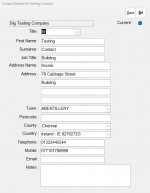I found code for creating detailed field level audit funtionality and I copied. It is really good as I can added alot of additional details about who, what & when in the audit table. However, I've spotted then the form has a Rowsource that is a One to Many Query, the functionality doesn't work for the field from the One side of the query. Have scroll through many post and it clear the this code used by many, and I attached the code.
Example: Telephone number if in the primary table (Contract) and address name is in the many table (addresses). If I change any address field it works, but if I change telephone number (is bound) if fails, but it it have no address name. Although address name already has a value and is bound and is a text box .oldvalue is blank and shows as a variant/integer. if I remove the tag 'Audit' from address name the it fail on next field address Line 1. I've check address table to ensure all field are text and check the form that all field are text box.
Any help on why it doesn't work?
Thanks

Example: Telephone number if in the primary table (Contract) and address name is in the many table (addresses). If I change any address field it works, but if I change telephone number (is bound) if fails, but it it have no address name. Although address name already has a value and is bound and is a text box .oldvalue is blank and shows as a variant/integer. if I remove the tag 'Audit' from address name the it fail on next field address Line 1. I've check address table to ensure all field are text and check the form that all field are text box.
Any help on why it doesn't work?
Thanks




